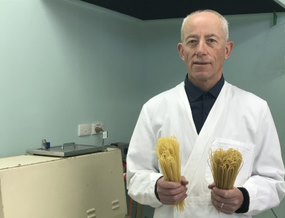
In a win for pasta lovers, a recent study has discovered how to make the perfect pasta; by combining eating quality with health benefits to reduce lifestyle diseases with nutritious, low glycaemic index (GI) pasta.
NSW Department of Primary Industries (DPI) principal research scientist, Mike Sissons, said in a world-first the DPI joined with Italian food scientists to analyse the GI of spaghetti made from speciality durum wheat with elevated resistant starch levels.
"Elevated starch levels can improve insulin sensitivity, lower blood sugar levels, reduce appetite and provide various benefits for digestion," Dr Sissons said.
"Tests of 10 healthy adults confirmed consumption of pasta produced from the speciality durum wheat was able to lower the GI.
"One variety of speciality durum, SBEIIa, showed a clear benefit and could be used to produce pasta with a lower GI than regular pasta.
"Additional tests showed the quality of pasta produced by SBEIIa was also acceptable to consumers and much more appealing than wholemeal spaghetti.
"The speciality wheat produces a higher level of starch compared with normal durum wheat, offering the potential to alleviate lifestyle diseases, including type 2 diabetes and cardiovascular disease.
"Regular durum semolina pasta is high in protein but not an ideal source of dietary fibre as most is removed during milling. Wholemeal pasta offers high fibre health benefits but is not as popular with consumers due to its different appearance and taste.
"The key was to modify the nutritional value of the refined wheat products, while largely retaining the sensory qualities and consumer appeal of regular pasta rather than adding bran, wholegrain meal, legumes or gums to improve fibre content."
Italian researchers bred two specialty durum wheats, SSIIa and SBEIIa, by crossing the Svevo Italian variety with mutant lines which increased the amylose content.
Final analysis suggested a minimum resistant starch content of around seven per cent is needed to lower GI in spaghetti, which corresponded to an amylose content of around 58 per cent.
The research was recently published in the international journal, Foods.
Research was conducted by NSW DPI at its Tamworth and Wagga Wagga Agricultural Institutes, and the University of Bari, Italy. Research was funded through NSW DPI, Agroalimentare e Ricerca and the Italian Ministry of Education, University and Research.






